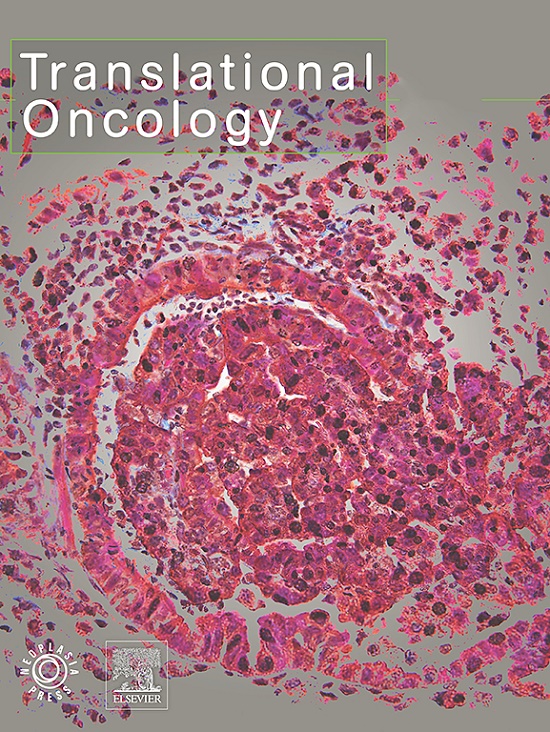HERVs 转录组学揭示了胃癌 LTR5_Hs 和 HERVS71 位点的临床生物学特征
IF 5
2区 医学
Q2 Medicine
引用次数: 0
摘要
人类内源性逆转录病毒(HERV)是内源性转座元件(ETE)的一种,已成为癌症的潜在生物标志物和治疗靶点。然而,胃癌(GC)中 HERV 元的转录相关性在很大程度上仍未得到探索。本研究旨在阐明胃癌患者中 HERVs 位点特异性表达与临床动态之间的相互作用。我们比较了肿瘤和邻近组织 RNA 测序的 HERVs 位点特异性表达谱,并使用 GEO 数据库和 RT-PCR 进行了验证。与邻近的非肿瘤组织相比,分析发现肿瘤组织中有 113 个 ETE 上调,46 个下调。在 HERVs 支系(如 HERVK、HERVS71 和 HERVH)中发现了显著差异。通过 RT-PCR 在血清样本中验证了四个临床相关的 HERV 元素--LTR5_Hs_1q22 和 HERVS71_19q13.22(int、rve、RNase_H)。与低表达组(HERVslow)相比,HERVs 高表达组(HERVshigh)与肿瘤体积增大、分级升高、淋巴结转移增加和 Odds 比值升高相关。四种 HERV 元素的诊断性能超过了传统的生物标记物,并通过联合生物标记物分析得到改善。差异和功能分析表明,这些 HERV 元件对细胞周期有显著影响,其上调与体外和体内的肿瘤生长有关。我们的研究证明了 HERVs 在肿瘤进展中的临床意义,突出了其功能性作用,为开发 GC 新的生物标记物和治疗靶点提供了宝贵的资源。本文章由计算机程序翻译,如有差异,请以英文原文为准。
Transcriptomics of HERVs reveals clinico-biological characterization of LTR5_Hs and HERVS71 loci in gastric cancer
Human endogenous retroviruses (HERVs), a type of endogenous transposable elements (ETE), have emerged as potential biomarkers and therapeutic targets for cancers. However, the transcriptional relevance of HERV elements in gastric cancer (GC) remains largely unexplored. This study aims to elucidate the interactions between locus-specific HERVs expression and clinical dynamics in GC patients. We compared HERVs locus-specific expression profiles from RNA sequencing of tumor and adjacent tissues, validated using the GEO database and RT-PCR. Analysis of dysregulated ETEs revealed 113 upregulated and 46 downregulated ETEs in tumor tissues compared to adjacent non-tumor tissues. Significant differences were found in HERVs clades such as HERVK, HERVS71, and HERVH. Four clinically relevant HERV elements—LTR5_Hs_1q22 and HERVS71_19q13.22 (int, rve, RNase_H)—were validated in serum samples via RT-PCR. Higher HERVs expression (HERVshigh) correlated with larger tumor size, higher grade, increased lymph node metastasis, and higher Odds ratio compared to lower expression (HERVslow) groups. The diagnostic performance of the four HERV elements surpassed that of conventional biomarkers and improved with combined biomarker analysis. Differential and functional analysis indicated that these HERV elements significantly impacted the cell cycle, with their upregulation linked to tumor growth both in vitro and in vivo. Our exploration demonstrates the clinical significance of HERVs in tumor progression, highlighting their functional role and providing a valuable resource for developing new biomarkers and therapeutic targets in GC.
求助全文
通过发布文献求助,成功后即可免费获取论文全文。
去求助
来源期刊

Translational Oncology
ONCOLOGY-
CiteScore
8.40
自引率
2.00%
发文量
314
审稿时长
54 days
期刊介绍:
Translational Oncology publishes the results of novel research investigations which bridge the laboratory and clinical settings including risk assessment, cellular and molecular characterization, prevention, detection, diagnosis and treatment of human cancers with the overall goal of improving the clinical care of oncology patients. Translational Oncology will publish laboratory studies of novel therapeutic interventions as well as clinical trials which evaluate new treatment paradigms for cancer. Peer reviewed manuscript types include Original Reports, Reviews and Editorials.
 求助内容:
求助内容: 应助结果提醒方式:
应助结果提醒方式:


